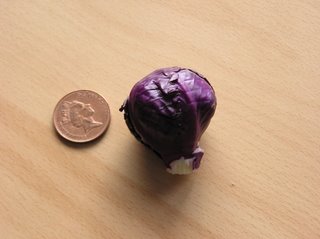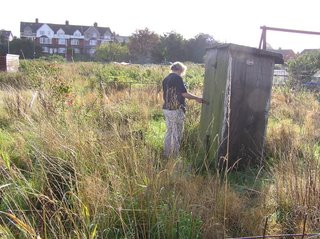Wednesday, December 27, 2006
Monday, December 25, 2006
A grey Christmas
They were very nice parsnips, though, and with a 'food miles' footprint of around 15 feet. Next year, with the allotment in full flow, we should also be eating home grown sprouts, carrots and I may try for some Christmas new potatoes grown in a container in the unheated greenhouse. Don't think I'll bother trying for a homegrown turkey, though.
We were down at the allotment last week, where I planted out some broad beans which I started off in the greenhouse. Typically, we then had a big frost (it having been pretty warm up until then). Still, I have some more broad beans still in the green house, and will sow some more in the spring. The strawberries are looking healthy down there.
In the garden, there is a purple hellebore in flower, with big fat buds on a white hellebore. The chard 'Bright Lights' is looking good, but I still haven't harvested any. The leeks are still looking rather spring onion-like (sowed them and planted them out far too late, and they're in a bit of the garden where there are bricks not far below the surface).
For those who have rather more homegrown veg than we do, the Womens Food & Farming Union have a nice web page with seasonal fruit and veg recipes:
http://www.wfu.org.uk/seasonalveg.htm
One pink rose flower in the front garden - we've often had roses flowering this late.
Nights are getting shorter now (but not discernably, sadly) and the birds seem to think spring has sprung. It won't be long before the heating is turned on in the greenhouse and the first few lots of seed sown (celeriac and tomotoes being amongst the first, in February). Can't wait! Until then, there's a little more digging to do on the allotment, and planning a rotation system.
We'll be off to Ness Gardens sometime over the Christmas holidays, no doubt, and will look forward to seeing the start of a new season there.
Wednesday, December 06, 2006
It's dark...
I finally got around to planting the tulips this weekend, with 'Wendy Love' in the back garden and a mix of 'Recreado' (dark purple) and 'Douglas Bader' (pink). I've planted them in the space vacated by the Lavatera bush, which I dug up in a fit of tidying last weekend. I'd planted it in the wrong place, and it was all over the path. It has produced a lovely space (hence the tulips) and have just got a nice Sarcococca shrub to plant there - much slower growing and with fantastically fragant flowers over winter, next to the front door.
The dark nights (and ongoing comments about my untidiness by Mr HM) have led me to tidy up the seed packets strewn about the place and have ordered them according to date of sowing. Roll on spring, and the seed sowing time...
Thursday, November 09, 2006
Gardening in the dark
On the allotment front, more beds were dug, and lots of couch grass extracted. Also, I planted 15 strawberries of 3 different varieties ('Mae', 'Florence' and 'Alice') - these will spread out the harvest season, hopefully.
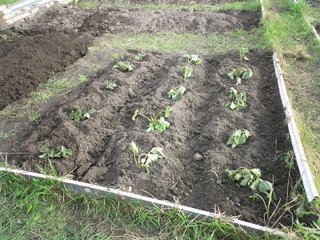
Thanks to Henry for directions on strawberry planting and some compost to feed the plants, as it will be a while until our pile of weeds is reduced to a useable compost.
Weather-wise, it has become a little milder, with a small amount of rain yesterday. I think we'll be off to see the last flowers of the year at Ness Gardens this weekend; I'm sure that the herbaceous borders will still have a few blooms.
Friday, November 03, 2006
First Frosts
We'll be having a busy weekend at the allotment, as we have only two or three new beds to dig to complete it, and I've had a couple of deliveries. One was of 'elephant garlic' which was bought on a whim as it was on special offer. Apparently it is a mild garlic flavour, more like leek. Also, I've got a delivery of bare-rooted strawberry plants, of three different varieties - to give a longer cropping season (again, a special offer!). I'll put these in a dedicated strawberry bed. The strawberries should crop for three years before needing to be replaced, and the bed rotated. I've only just started being able to eat strawberries - for many years they'd make me ill. However, after picking some at a PYO last summer (http://www.clivesfruitfarm.co.uk/), I now realise what I've been missing out on. Can't wait to harvest my own strawbs next summer.
In the mean time, it's an opportunity to enjoy some proper autumn weather, with spiders' webs sparking with dew, and the leaves starting to come down with a vengeance - an excellent resource which will be turned into leaf mould, to put on the Hellebores next autumn.
Wednesday, October 25, 2006
Autumn colour
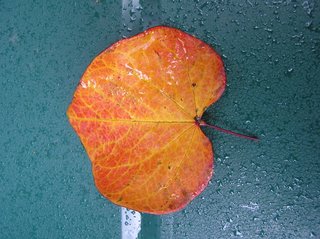
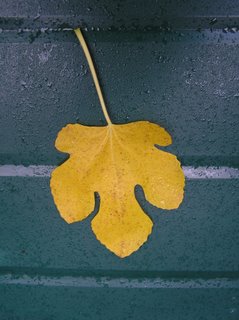
It's been much colder over the past couple of days, so it looks like autumn is finally here. The trees are turning now, with yellows showing through the greens. Of course, down the allotment, it's mostly browns, although the 'Winter Density' lettuce are up.
The remains of the Calendula will have to be pulled this weekend - they've done well. As soon as the frost hts, the Ricinus and Dahlia will become sludge.
Mr HM took some nice photos of a fig leaf and a Cercis canadensis 'Forest Pansy' leaf. Beautiful colours.
Sunday, October 15, 2006
Not quite self sufficient!
My, how Mr HM laughed!
On the positive side, the allotment is gradually taking shape and today became a 'proper' allotment, with some garlic (courtesy of Henry - thanks!) planted, and a line of rather optimistically sown 'Arctic King' lettuce. I may need to supply some protection for these, assuming that the slugs and snails don't get to them first. The navvy and I dug two more beds and rather over-keenly started on the next beds, but soon realised our mistake. A couple more weeks of digging and it will all be sorted. I'll plant some green manure in most of the beds over the winter, to out-compete the weeds.
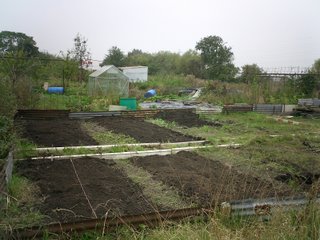
Two new beds, and the optimistically started 3rd row of beds...
I've also ordered some raspberries for the allotment: 18 canes for £21, with 6 canes of three different varieties, spreading the harvest from mid July to autumn. I've got 5 canes of 'Octavia' in the garden, which went in last November, and gave a small but delicious harvest this summer - it took me back to picking raspberries in my grandad's garden when I was little.
A bit chillier today and the sky has been a dull grey all day. Perhaps autumn is finally with us - the leaves are now yellowing on the trees along the front of the road. Surprisingly, the Indian Bean tree (Catalpa bignoniodes) has still got all of its leaves - like my parents' Robinia pseudoacacia 'Frisia' it's normally very late to gain its leaves and very early to lose them.
The Jay has been visiting the back garden this week, which is lovely to see. They are a very colourful member of the crow family, with a raucous call. Its favourite food is acorns, but it seems quite content with the peanuts supplied by us.
Saturday, October 14, 2006
My name is HappyMouffetard, and I have a problem...
It's not my fault, the pushers produce shiny catalogues, filled with so many promises. The rush of ordering on-line, the anticipation of the parcel arriving. The excitement of unpacking the parcel and reviewing all the different packets of hope. And, in the case of the package I got this morning, the joy of separating the hungarian rye seeds from the mangetout seeds, the packets of which had burst in transit.
Then, the fun of planting the seeds, the anticipation of the first hint of green appearing through the compost. But with the highs come the lows ... the devastating slug attacks, and when you go away at the weekend, only for it to be the hottest weekend on record, causing the seedlings to shrivel. And, even when you've carefully nurtured the little darlings, snail families take up residence in the cabbages, leading to ... well - I'll post the pictorial results of that little disaster tomorrow. Suffice to say, self sufficiency in red cabbage will not be happening this year.
Still, forced labour for Mr HM down the allotment tomorrow, and my wild over-optimism and enthusiasm will lead me to try planting a few lettuce 'Winter Density'. Mind you, a blue tit was cheerfully singing this morning, and if he thinks it's spring, then me planting a few seeds is a minor triumph of optimism over sense compared to his seasonal confusion.
Sunday, October 08, 2006
The kindness of the allotmenteer

Veg courtesy of Harold
Today my labourer and I (thank you Mr HappyMouffetard!) double dug two 4 foot wide beds at the bottom of the plot. We dug out plenty of perennial roots as we went, but no doubt plenty more remain. Another couple of months and we'll have all of the beds dug (no point over-exherting ourselves!). The soil is nice & rich, with a sandy layer below - ideal for decent drainage. Now I'm just waiting for my asparagus plants to arrive.

On the home front, I've just trimmed the lawn edges, and done some deadheading of Dahlias and Rudbeckias (annual and perennial) to try and encourage a few more final blooms. I'm planning on buying a Viburnum shrub for the front garden, to give some fragrance over winter. I've found Crocus a good site for shrubs - excellent quality and the shrubs don't seem as expensive as the herbaceous plants they sell!
Saturday, October 07, 2006
Waiting for frost
The smell of autumn is so evocative. It brings back memories of dahlias being prepared for showing (dad was a very successful shower of dahlias in the '70s). The smell of vegetation starting to break down, wood smoke and the smell of an imminent frost. Fantastic. It may be a foretaste of the cold and dark of winter to come, but to live in a country with such different seasons is amazing.
Putting the garden to be is the key job of the moment, although there are still plenty of blooms in the garden. The Schizostylis coccinea is still looking great, as are the Japanese anemones. The Verbena continues to attract butterflies into the garden. Mr HappyMouffetard trimmed the lavender flower heads and mowed the lawn, which is still growing quickly and completely recovered from the lack of water through July. Tomorrow we're down on 'the plot' to start digging beds, so hard work ahead. The beds may have to be double dug, with a lot of forking to remove perennial weed roots. No doubt more photos of the hard work to follow tomorow.
Sunday, October 01, 2006
Conquering the Wilderness!

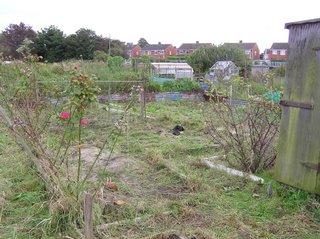
After...
The site is not very full, which is a shame. Hopefully it will start to fill up, as allotments are having something of a renaissance at the moment. There is evidence of some allotments coming into recent cultivation, so fingers crossed it will get fuller.
As for us, we're tired, stung, aching but with a real sense of achievement!
Ness Botanic Gardens
Ness Gardens are based on the Wirral Peninsula in North West England. The gardens now belong to the University of Liverpool, but were originally privately owned. Although not huge, there is certainly enough there to keep a keep plantophile interested for a few hours.
It's a good place to visit all year round, with hellebores and a snowdrop collection in the early part of the year, and the late colour herbaceous border at the moment is looking fantastic. We are 'friends of Ness' and go regularly - encouraged by the delicious home-made cakes (the coffee and walnut cake is fantastic!)
It has several glasshouses - one harbours a nice collection of carnivorous plants, another has desert plants.

(Pitcher Plant from Ness Gardens)
See the side bar on the right for a link to their website.
Friday, September 29, 2006
Hurrah!
Lots of rubbish to pick up, lots of weeds (although some areas are covered with carpet). Still, little by little it will be claimed back and gradually tamed. And then... I can see in my mind's eye what the plot will look like, but hard graft and time will be needed.
In the garden at home, the chard is now growing well, (cultivar: 'Bright Lights'). It's an attractive plant, with the seeds coming up with a mix of stem colours (orange, red and yellow). The Verbena bonariensis are seeding like crazy, as are the forget-me-nots. Ruthless culling will take place in Spring, as I was a bit lax this year and the front garden was rather rampant.
After a rather stressful week at work with an Ofsted inspection, getting tired and dirty in the garden is called for.
Thursday, September 21, 2006
Impatience
Autumn planted asparagus can be harvested very lightly in the first spring - perhaps one or two spears per plant in the first two years. However, after the second year, it can be harvested more heavily, until the longest day (my birthday! Give it a couple of years and my birthday will be celebrated by the last asparagus of the year - what a birthday present!).
I'm off to the Malvern Autumn Gardening Show this weekend - it's good to see the dahlia exhibits and the vegetables at this time of year. Perhaps the allotment paper will arrive over the weekend, so I can get started on growing my own...
Sunday, September 17, 2006
Sweet September
I much prefer the miniature daffodils in the garden; I spent some time yesterday planting 'Minnow' and 'Tete a Tete'. Also planted were a range of Alliums, which give excellent value - the flowers last several weeks, and the heads remain all year.
Today, the weather is not so nice, but I will be in the front garden; here, I will be planting more miniature daffies, as well as a Crocus mixture, and some Anenome blanda. I am also going to plant up a couple of pots with pink and blue hyacinths. These should produce a fantastic perfume when they flower; during the dull winter and early spring, the fragrance of hyacinths, the viburnum and the sweet box (Sarcococca) will bring a bit of glamour to the front garden.
Growing bulbs is fantastic - just plant them in the ground (as a general rule at a depth of three times their height), and nature does the rest - the bulb contains embryonic roots, shoots, leaves and flower - just add soil & water! The BBC website has some useful information on planting bulbs, along with some bulbs to try, and aftercare details:
http://www.bbc.co.uk/gardening/basics/techniques/plant_bulbs.shtml
Tuesday, September 12, 2006
Planning ahead
As well as the usual daffies and crocuses, I have found that miniature irises can really brighten up a pot or window box in the early spring. So this weekend (as well as peering at the allotment again...) I will be planning & planting the bulbs. The tulips, however, will be kept in a cool, dry place until November before being planted. This reduces the risk of them getting viruses. I always like to plant a few Tulip 'Wendy Love', in memory of my mum; they're a soft apricot and yellow - sounds strange but the colour goes very well with the bark and new leaves of a Japanese Acer in the back garden.
Bulbs are so easy to plant and give you something to look forward to over the dark, cold months of winter.
Monday, September 11, 2006
My ever increasing kingdom...
It is, apparently, a trendy thing to do now, but I've always had a bit of a hankering. It must have been watching 'The Good Life' when I was young & impressionable. Hubby is pleased - it will mean the end of me trying to use red cabbages and cauliflowers as edging plants in the herbaceous borders.
So, I can't wait to get the piece of paper to sign, and go and take control of my little plot of wilderness. We'll see how well the enthusiasm lasts when waging war against bindweed and brambles.
A wonderful forum on growing your own can be found here:
http://www.growfruitandveg.co.uk/grapevine/index.php
Saturday, September 09, 2006
Weekend jobs

It's a beautiful sunny weekend, although the mornings are definitely getting cooler. So, this weekend it's a case of:
- aerating the lawn (one of last weeks jobs not yet done)
- carry on weeding
- chopping down the dead heads on some of the Achillea, to try & stop it seeding like it did last year
- thin out the Cerinthe seedlings - another plant that spreads itself around a bit. Beautiful in early summer.
The insects are getting fewer in the garden, but it's been a great year for butterlies, lke this Peacock on the Buddleia 'Harlequin'.
Thursday, September 07, 2006
Great big thistles
The cardoon is a majestic member of the thistle family. One of the specimens out the front must be around 8 feet tall, with around 20 flower heads on it. The flowers are adored by the local invertebrate wildlife. There are bumble bees, honey bees, four or five species of butterfly and also hover flies on the thistle heads.
This end of the season, they are starting to look a little worse for wear, but will make a strong architectural 'statement' through the winter, and their foliage and dead flower heads may act as shelter for resident insects.
I think they are a little overwhelming in our small front garden though - the plant which got blown over in June and has grown back from the base is a far more manageable (although less dramatic) 4 feet. So perhaps if the cardoons are to stay next year, I'll perform a bit of a 'Chelsea chop' on them, to keep them a more manageable size but keep them flowering and providing a little late summer colour.
Details on the 'Chelsea chop' can be found near the bottom of the page on the following link.
http://www.rhs.org.uk/thegarden/pubs/garden0805/perennialcuts.asp
Wednesday, September 06, 2006
An exciting time of year...
It's the time of year for seed catalogues to start dropping through the letterbox.
Lots of planning to do. My husband will laugh at this, as there is still a pile of unopened seed packets sat on top of the microwave, collected through Spring and Summer. To be fair, I didn't buy any of these - they're all free from various magazines, most notably Garden News.
Still, shiny new catalogues with lots of bright new flowers and varieties of veg. A pleasant way to spend a wet autumn evening or weekend.
I've always found Thompson & Morgan to be excellent, but there are lots of other large companies, as well as smaller specialist companies. I like the look of the new Calendula 'Sherbert Fizz' T&M are showcasing this year:
http://seeds.thompson-morgan.com/uk/en/product/gww4501/1
It's cute!
Tuesday, September 05, 2006
Best Laid Plans
Mind you, most of the moss in the garden is on the shady border in the back garden, so that needs digging and having some organic matter added, to open up the drainage a bit.
I'm pondering putting in some broad bean seeds to overwinter. I'm not sure if this is a good idea 'up North', but worth a try to get an early crop next year. Mind you, with only growing veg in a small garden, anything is worth an experiment. With the amount of rain we're getting at the moment, it may be worth having a go at cultivating rice...
Monday, September 04, 2006
The sad autumn song of the robin

Yesterday morning I heard the 'ticking' and melancholy song of the robin - a sure sign of impending misty Autumn days.
I like the changing of the seasons: the heavy dew on the spiders webs in the garden; the smell of rotting vegetation; dahlias and asters flowering; even the sudden disintegration of the tender perennials - castor oil plants in particular disintegrate almost instantaneously when the thermometer reaches frost levels.
The chilli plants have done very well this year; I've just used one to make a chile con carne. The only problem being how to gauge the hotness of the first chilli pepper of the season. Well, we'll find out tomorrow, when we will either reach for the tabasco sauce to spice things up a bit, or rush to the kitchen with mouths on fire.
The Royal Society of Chemistry has some interesting information on the chemistry of chilli peppers: http://www.chemsoc.org/exemplarchem/entries/mbellringer/
Still no sun to ripen the butternut squashes. We do, however, have an extraordinarily fine crop of slugs. It's a shame that they are not considered a gourmet's invertebrate like the oyster - we'd make a fortune! Slug egg caviar, anyone? I could be onto a winner!
Sunday, September 03, 2006
Slowly learning...
I get a sense of satisfaction from learning, and learning combined with my hobby is better still.
The General Certificate is suitable for all, including hobby gardeners wishing to learn a little more about the whys and wherefores of plant growth and cultivation.
It's something to do in the dark winter evenings, which are quickly coming upon us...
Exotic Caterpillars
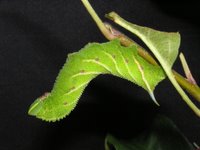 This is the caterpillar of the Eyed Hawkmoth. It likes apple leaves; so much so, that my poor new apple tree has barely half a dozen leaves left thanks to this critter and its siblings.
This is the caterpillar of the Eyed Hawkmoth. It likes apple leaves; so much so, that my poor new apple tree has barely half a dozen leaves left thanks to this critter and its siblings.Still, if you're trying to attract wildlife, you can't pick and choose.
Today's garden tasks are to:
- rescue the lavatera, which has lurched dramatically over the path after yesterday's wind;
- aerate the lawn - dull but necessary to reduce compaction;
- deadhead dahlias, rudbeckias and calendulas, so that they keep on flowering through autumn;
- weed, weed, weed - the recent rain has caused everything to grow like crazy.
Saturday, September 02, 2006
Liquid Snow
 The joy of the English weather...
The joy of the English weather...Lush grass, sodden herbaceous border.
Still, an excellent start to my attempt at growing edible and ornamental plants together.
So many crab apples that a branch has snapped - note to self: make sure you thin them out in June next year.
Three apples on the brand new 'supercolumn' tree, and two on the cooking apple tree.
A huge harvest of at least 20 raspberries on the new canes; over 30 blackcurrants. And more courgettes than you can shake a stick at. If the weather Gods could give us three months of warm weather, I may even get a ripe butternut squash.
On the down side: snails & slugs galore on the red cabbages dotted about the garden. I've been using the excuse of specially bred 'lacy' cabbages.
Somehow 'liquid snow' sounds so much better than rain...
